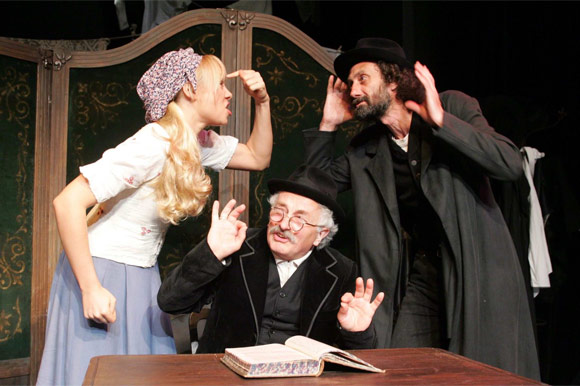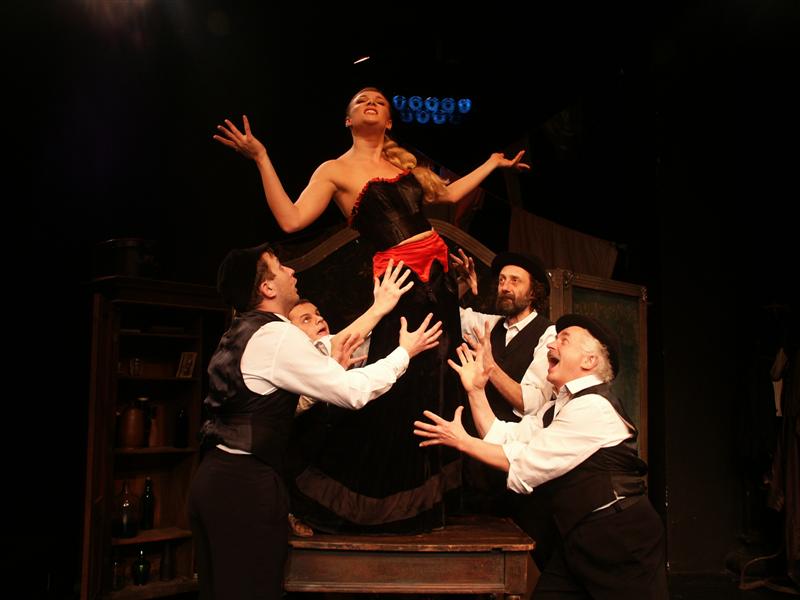Skład aktorski:
- Katarzyna Chlebny/ Marta Bizoń / Kamila Klimczak
- Karol Wolski / Marcin Kobierski
- Tadeusz Kwinta / Kajetan Wolniewicz
- Andrzej Róg / Tadeusz Zięba
- Albert Pyśk / Jacek Stefanik
Scenariusz i reżyseria: Rafał Kmita
Muzyka: Bolesław Rawski
Scenografia: Elżbieta Wójtowicz-Gularowska
Choreografia: Jarosław Staniek
Dotychczasowa ilość przedstawień: 330
„Aj waj! czyli historie z cynamonem” to na poły kabaretowy na poły teatralny spektakl osnuty na motywach kultury żydowskiej.
Na jakiś stary, dawno już nieodwiedzany strych wchodzi grupka aktorów, którzy z porzuconych przed laty przedmiotów – pożółkłych gazet, książek, słoików, nakryć głowy – wyczarowują raz śpiewane, to znowu mówione opowieści. Piosenki przeplatają się z komicznymi scenkami i monologami.
Dziennik „Rzeczpospolita” uznał „Aj waj! czyli historie z cynamonem” za jeden z czterech najlepszych spektakli teatralnych 2005 roku, natomiast tygodnik „Przegląd” umieścił go w dziesiątce najważniejszych wydarzeń teatralnych ubiegłego sezonu. Ponadto na festiwalu Komedii Talia 2005 „Aj waj!…” otrzymał nagrody za najlepszą inscenizację oraz najlepszą muzykę.

Żarty i mądrości narodu wybranego
Pełne dwie godziny żydowskiego humoru najwyższej klasy. Po „Aj, waj! Czyli historie z cynamonem” widzowie nie chcieli wypuścić aktorów ze sceny. W repertuarach teatrów próżno by szukać takiego ładunku humoru i życiowej mądrości. Zabawnej i dającej do myślenia. Spektakl „Aj, waj! Czyli historie z cynamonem” Rafała Kmity spełnia wszystkie te wymagania. Wystarczyło sięgnąć po wielowiekową tradycję narodu wybranego i doświadczenia rabinów oraz wrodzoną pomysłowość pokoleń żydowskich kupców, rzemieślników, mleczarzy i gospodyń domowych oraz wiecznie zbuntowanych wobec tradycji młodzieńców. Kmita potrafił zaginiony świat ożywić w teatrze. Zestawił z niego serię scen, naładowanych dowcipem. (…)
Na scenie pojawia się gama kolorowych typów ludzkich: swat, chcący opchnąć postarzałemu kawalerowi pannę, rabin wyczekujący Mesjasza czy handlarze szukający naiwnych klientów. Kmita żarty umiejętnie oprawił puentami, scenki bawią nie tylko słowem, ale i zestawieniem postaci. Tekst uzupełnia wielobarwna muzyka Bolesława Rawskiego. Raz pogodna i figlarna, że aż nogi same niosły do tańca, w innym miejscu melancholijna i nostalgiczna. Dla takiego materiału Kmita musiał dobrać odpowiednich wykonawców. Na scenie wyróżnia się Sonia Bohosiewicz, niepospolitej urody dorodna blondynka obdarzona temperamentem. To ona nadaje spektaklowi momentami zupełnie szalone tempo. Kiedy z mężem przychodzi do rabina, aby się rozwieść, jest istnym wcieleniem diabła w spódnicy. Jednym tchem wyrzuca, że jej mąż to niedorajda i jest tak głupi, że nawet jak chrapie, to chrapie same głupoty. Ale już w następnej scenie Bohosiewicz tkliwie śpiewa kołysankę. Nie ustępuje jej piątka aktorów z Tadeuszem Kwintą na czele. Razem dali taki koncert, że publiczność zmusiła ich do czterech bisów. Znaczy, że się podobało.
Tomasz Wysocki „Gazeta festiwalowa” Wrocław, 18-19 marca 2006

Żywioł wykwintnego humoru
Przedstawieniem „Aj waj! czyli historie z cynamonem” Grupa Rafała Kmity z Krakowa otworzyła we wtorek V przegląd Komedie lata” w Teatrze Na Woli. Zrobiła to w pięknym stylu, kontynuując najlepsze tradycje polskiego kabaretu literackiego. Wszystko w tym widowisku ma stempel wysokiej jakości i świadczy o przednim poczuciu humoru zespołu twórców i wykonawców.
Autor i reżyser Rafał Kmita ma niezwykle czułe ucho na brzmienie żydowskich szmoncesów, skeczy czy piosenek. Wręcz wyczuwało się radość, jaką odnajdywał w ich pastiszu. Wspierał go znakomitymi kompozycjami Bolesław Rawski. Mimo nostalgii za minionymi czasami spektakl był wolny od sentymentalizmu i martyrologii.
Kabaretowe z ducha numery opracowane zostały z wielką troską o słowo. Dowcipy puentowały każde wydarzenie po wielekroć. Towarzyszyły im niezwykle pomysły inscenizacyjne, z popisowym numerem z butelkami i innymi przedmiotami codziennego użytku, które imitowały instrumenty muzyczne. Wdzięk i polot piątki wykonawców godzien jest osobnych analiz. Pełna ekspresji Sonia Bohosiewicz bawiła jako typowa mame, to znów małżonka chętna do rozwodu czy panienka lekkich obyczajów. Urok osobisty i wokalno-taneczne usposobienie Tadeusza Kwinty czyniły go wiarygodnym tate, krawcem, swatem i rabinem, rozstrzygającym swary między małżonkami. Andrzej Róg popisową piosenkę o zahukanym mężu, który rusza sprzedać kozę, gdy wtem: „stoi karczma – no to wchodzę”, zachował na bisy. Marcin Kobierski śpiewał z uczuciem o kobiecie idealnej, której jedyną wadą było to, że istniała tylko we śnie. Takie przedstawienie też się mogło jedynie przyśnić, ale ma tę zaletę, że będzie jeszcze do obejrzenia. Do czego każdego namawiam.
Janusz R. Kowalczyk, „Rzeczpospolita”, 6-7 sierpnia 2005

Kulturałki
(…) A może udać się na urlop ze spektaklem „Aj waj!, czyli historie z cynamonem” w pamięci, co go Rafał Kmita w Teatrze STU wystawił. Przez sto minut bawiłem się w wypełnionej szczelnie sali STU podawanym z wdziękiem humorem – sytuacyjnym, słownym, muzycznym; raz jeszcze Tadeusz Kwinta pokazał swą klasę, raz jeszcze I Andrzej Róg dowiódł swego talentu i edukacyjnej siły Studia Aktorskiego, jakie kiedyś działało przy STU, raz jeszcze Sonia Bohosiewicz potwierdziła, że nie przypadkowo tak świetnie wypadła, grając blisko sześć lat temu obok Anny Polony, swej pani profesor z PWST, w „Twórcach obrazów”. Dobrze, że ma tego Kmitę… A on – pokazał literacki smak, poczucie humoru i fenomenalną zdolność, jak na człowieka, który wyszedł z kabaretu, przystało, puentowania scen. Niektóre puenty aż giną – przykryte zwielokrotnionym śmiechem; a tu po trzeciej i czwartą rozrzutnie dopisał autor i reżyser zarazem. Reżyser, który poprowadził spektakl w znakomitym rytmie, na ,,zakładkę”, bez zbędnych pauz. Bez modnych szarż. Zachwycał się już spektaklem Kmity Paweł Głowacki, ale on musiał o swoim Marguezie napomknąć (on ma cholera, lepsze, obsesje…), zatem już mu się nie napisało o muzyce, jaką ofiarował Kmicie do spektaklu Bolesław Rawski. Kompozytor od lat tworzący w Krakowie, a zarazem pozostający w cieniu innych. Wielkich. Nie wiem, jak Mistrz Zygmunt Konieczny odebrał te muzyczne frazy, ja byłem wielce ukontentowany (Głowacki też, a nie napisał.) Nie wiem, bo bodaj nikt wie, czy będą w tym roku ogłoszone nominacje do statuetek Ludwika – w kategorii muzyka byłby Rawski jednym z pewnych kandydatów!
Wacław Krupiński, „Dziennik Polski”, 4 czerwca 2005

Zabawny i nostalgiczny spektakl Rafała Kmity w Teatrze STU
W starym pudle drzemie cały świat. śpi w nim zamknięty krawiec, co chciał szyć marzenia i jego pomocnicy, kręcący się w miejscu swoich myśli. Cały świat się obudzi, gdy podniesie się wieko skrzyni, a miłosierna ręka stworzyciela nakręci zużyty mechanizm. Znów rozlegnie się stara, zapomniana melodia, wróci śmieszny żart przywracający porządek rzeczy.
Spektakl „Aj waj! czyli historie z cynamonem” Rafała Kmity przypomina starą pozytywkę. Nakręcony sprawną ręką reżysera, podszyty dźwiękami, co je kompozytor Bolesław Rawski pięknie ułożył, budzi uśpiony w zakamarkach pamięci żydowski skrawek świata, w którym ciasteczka z cynamonem smakują jak proustowska magdalenka.
Stara pozytywka ożywa na strychu pamięci, na który wchodzą przez otwór w podłodze aktorzy. Delikatnie biorą do rąk zapomniane przedmioty, jakieś porzucone kapelusze, jakieś garnki, które czasy swej świetności mają dawno już za sobą. To one przywołują w nich wspomnienia, prowokują do śpiewu, bądź też do opowiedzenia zabawnej historii, jak ta ze zbuntowanym synem i broniącym tradycji ojcem (doskonały Andrzej Róg, który rzeczywiście wygląda jak wszystkie nieszczęścia Żydów-tułaczy razem wzięte).
Za chwilę niemal rozpłaczemy się ze śmiechu, gdy zacierający ręce swat (Tadeusz Kwinta) będzie starał się wydać za mąż wszystkie możliwe – brzydule, pijaczki i staruszki w miasteczku. I wtedy, gdy jako pobożny, czekający na Mesjasza rabin, będzie wysłuchiwał skłóconych małżonków – Andrzeja Roga i Soni Bohosiewicz. Ta jedyna kobieta w przedstawieniu (grają na zmianę z Martą Bizon) wnosi ze sobą taką żywiołowość i energię, wobec której nikt nie może zostać obojętny, Aktorka potrafi jednak zmieniać nastroje i od radosnej zabawy przejść płynnie do wzruszającej kołysanki, którą żydowska matka śpiewa swojemu synkowi, przepowiadając mu ciężki los odmieńca.
I to jest najciekawsze w przedstawieniu Rafała Kmity, który wie, że każdy, nawet najśmieszniejszy żart żydowski jest podszyty smutkiem, pewnym rodzajem melancholii drzemiącej w rozrzuconym po świecie narodzie. Dlatego swój rozpędzony, kabaretowy mechanizm potrafi powstrzymać odpowiednim momencie, dorzucić do niego liryczną nutkę, zmienić rytm zapomnianej na strychu pozytywki, w której stary krawiec szyje swoje marzenia.
Magda Huzarska, „Gazeta Krakowska” 21 czerwca 2005
Polish actors reenact the shtetl better than any Jew
Krakow cabaret proves that small-town Jewish life is great material for theater.

Plenty of klezmer
At this stage the suspicious spectator (as distinct from the local Polish audience) realizes what’s nice about this play – largely skits and songs based on what’s known in Polish stage jargon as szmonces (shmontzes), routines of Jewish humor and popular wisdom The nice thing is that no one’s laughing at Jews but with them. Actually, not really with them, because so few Jews are left in Poland. But this show convinces with its affectionate, if not loving, attitude toward the Jewish world that knows how to laugh at itself and enjoys doing so.
Moreover, this performance is also a cabaret. Jacek Stefanik takes a bottle and two glasses out of the cupboard. He pulls the cork and the clarinet bursts into a series of klezmer trills. He puts the cork back in, pulls it out again and the music erupts anew.
Marcin Kobierski takes a second bottle out of the cupboard and out from under the cork erupts a second clarinet, even wilder than the first. Andrzej Rog takes a jar, and from under its cap bursts a trombone. Marta Bizon comes on stage with a fan, whose every flutter emits the sound of an accordion.
Gradually a scene of Jews with props becomes a musical celebration of a traditional-modern Jewish sound. It’s an imaginative dance with bottles and a lovely picture of life. This play has clear entertainment value but doesn’t hesitate to be sentimental; for example, when a mother sings to her baby, or in a song about the dream of Mendel the tailor.
Director, skit writer and troupe manager Rafal Kmita has run his cabaret for some 20 years now. „Oy Vay, Stories with Cinnamon” was first performed in 2005, when it won the prize for Polish cabaret. It has been performed throughout Poland more than 300 times (the theater in Krakow is one of its home bases). The cabaret has even performed the show with great success in France in front of a French, not Polish, audience, with captions. A recording of the songs, with original music by Boleslaw Rawski, has been a big seller.
When I tried to explain to myself the secret of success of this production with an audience that has no special interest in the topic (as I do) – apart from the good-spirited magic of the Jewish material itself – I concluded it was because this company, both as individuals and a group, has an infectious energy.
Toward the end, when the very Jewish music had taken on rhythms of contemporary dance club music, with bits of rap and hip hop, the encores began, with each actor doing an individual number. Outstanding was the song sung by Zelda-Rachel, the Jewish prostitute who offers her best wares to her Jewish clients, at a price anybody – and any body – can afford. At this stage the audience was applauding as if possessed by a dybbuk; it sounded like they would sit in that small auditorium all night if only the Jewish tales went on.
It was amazing – in Polish of all things, before a Polish audience, performed by non-Jewish actors (as far as I could tell, though toward the end they looked, as the Polish expression has it, “like a hundred Jews”). This “Diaspora” small-town Jewish material, which we in Israel have learned to scorn and shun in the name of Israeliness, provided full human-theatrical enchantment, with the necessary self-irony.
I emerged from this performance in Krakow, Poland, with the feeling that maybe it’s hard to be a Jew (and a Pole and an Israeli), but there are moments when this can be both charming and enjoyable. And somehow it seems odd that during the eight years this production has existed on Poland’s stages, no one has thought to bring it to Israel as a guest performance.
True, we’re a difficult audience, but it seems that with Hebrew captions, it’s a production that could convince even Israelis that there’s a certain fun in Judaism. Certainly stage fun.

